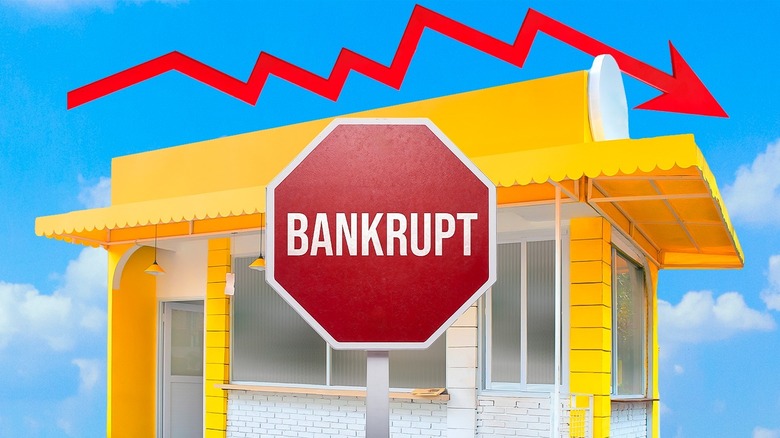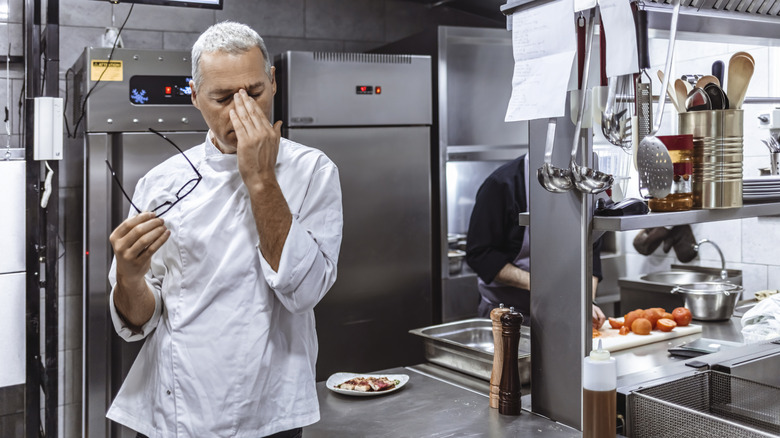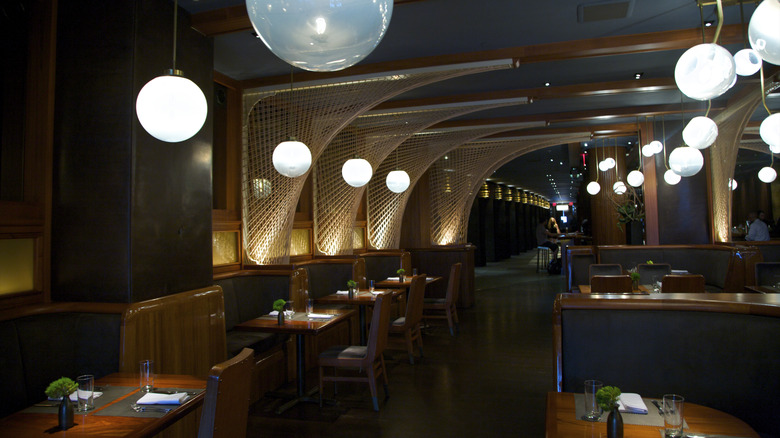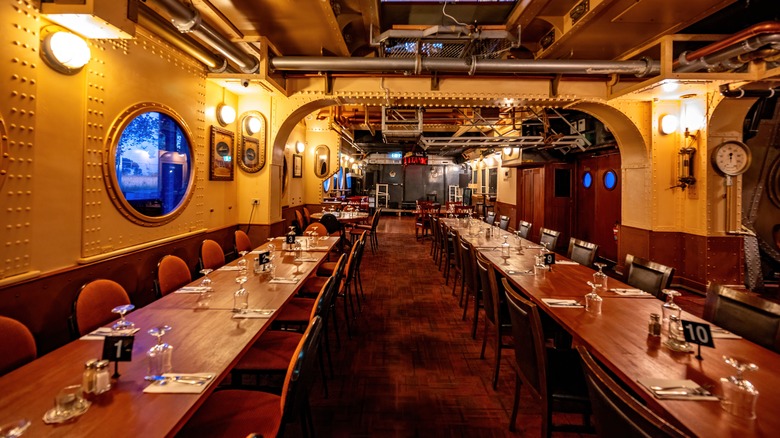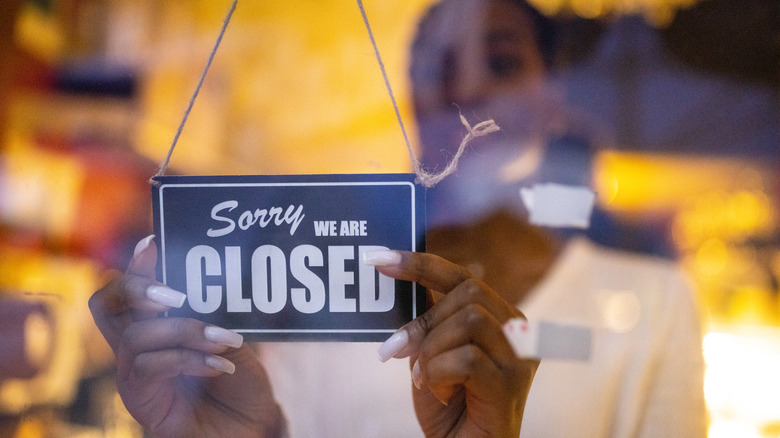The Tell-Tale Signs That A Chain Restaurant Is About To Go Bankrupt
There are many reasons why chain restaurants are beloved by their customers. They offer consistent menus and familiar experiences, giving us comfort in our dining choices. Your preferred chain restaurant can be your go-to whether you're feeling high or low. This is why it can be so jarring when they go bankrupt and close down. With sometimes thousands of locations, it can feel like these chains are immune to financial trouble. But as TGI Fridays and others have recently shown, even the most familiar of restaurants can be vulnerable.
If you're worried about a chain restaurant closing down, you've come to the right place. Here, we look at the tell-tale signs a chain may be in financial trouble. It's important to note these individual signs are just symptoms and don't give a full diagnosis. However, several of these signs at the same restaurant are a huge indicator that trouble is brewing. Whether you're an employee, investor, or merely an interested customer, here's how you can spot when a chain restaurant is about to go bankrupt.
Red flags on the accounts
Most of these signs you can pick up from being in the restaurant, but our first two are more for those who want a deep dive into the company. Looking into company accounts can give you some key indicators of financial health. One of those is negative cash flow, where a business spends more than it earns. This can happen to chains that seek aggressive growth to dominate the market, are making significant investments, or are relatively new — but regardless, it's usually a bad sign.
This is especially true if it's an established company whose growth has plateaued. You can also look for high levels of debt and whether the company has enough equity or earnings to cover this. Finally, a trend of declining revenue is a major warning sign, especially if a company already has negative cash flow and/or high debt. Analyzing accounts without training is difficult, as not everything that looks bad is actually bad. But even to the untrained eye, the factors mentioned here are often a sign that the company is facing severe economic challenges.
Check for insider selling
Insider selling — a form of insider trading — can be legal as long as it's done in the right manner. Whether legal or not, insider selling can happen when a shareholder fears the company is just about to tumble in value. They may have specific insider knowledge to make this decision (often illegal), but it may also be due to a gut feeling, as they have noticed one of the signs we look at here.
If those vested in the company are cashing out, it shows they have no faith in the chain's long-term stability. News of insider selling can also reduce stock value and deter investors. For those outside the company, insider selling can be detected by checking public filings, looking at trading platforms, and analyzing trends. It's natural for someone to want to limit their losses. If there is a trend of insider selling, it's a clear indicator people are jumping off the proverbial ship before the company goes bankrupt.
No franchise growth and canceled locations
Being an independent restaurant can be tough at the best of times, but for it to become a chain, it has to expand. The basic logic is that more locations mean more revenue and, hopefully, more profit. However, growth also comes with higher overheads, investment, and often taking on significant debt. When growth stalls, there's usually a strong reason behind it. Sometimes, a company wants to take stock and consolidate its position before pushing again, as growing too quickly can end up financially devastating companies. For others, it can be a sign that sales are dwindling, cash flow is stalling, debts are rising, or all of the above.
Rapid expansion without the cash flow to support it can lead to rapid implosion. Shareholders always expect the company they're invested in to get bigger and better. Slow growth or canceled locations will shake their faith and put off investors. This can lead to a drop in stock value and further financial strain. For potential franchisees, they may worry about a lack of corporate support. For some restaurant chains, they may feel they have grown about as big as they can get. For others, a lack of growth shows the money is running dry.
Frequent menu and brand changes
There are a few signs in this list that require context, and this is one of them. Most restaurants will make slight menu changes frequently to keep things fresh and keep up with trends. Also, brand changes aren't always a bad sign, as chains may feel the need to modernize. However, when mixed with other signs, this can mean trouble. If sales are declining, then a business will try and do something new.
The hope is that a menu change will attract new customers and breathe new life into the business. This can often backfire as it can cause a chain to lose its identity, with customers no longer knowing what to expect. Additionally, it can frustrate regulars who may suddenly find their favorite dishes removed. These changes cost money, and it can be a desperate throw of the dice. Branding changes, such as logo designs, can also happen. Again, this is an attempt to draw customers back to the restaurant by making the chain seem new and exciting.
A sudden drop in quality
The reason why so many people go back to chains is familiarity. The best example is probably McDonalds. Despite the rare bad experience, you know the quality of food you'll get and how quickly you'll get it. A struggling chain may risk familiarity with a drop in the quality of either food or service. This is usually a cost-cutting measure. A restaurant may opt for cheaper ingredients, smaller portion sizes, or even a reduction in staff training. When these budget cuts begin to affect the quality of the food or experience, regular customers will be quick to notice.
Frequent visitors will be loyal, but only to a point. They may think a drop in quality is a one-off, but if it keeps happening, they will go elsewhere. It can make sense that a struggling business would want to reduce costs, but if this comes at the expense of what you're providing to your customers, it's never a good move. Loyal customers will get fed up, and new customers will never return. If that happens, it's the beginning of the end. If a restaurant's reputation takes a hit, it can be nearly impossible to rebuild. Cutting corners becomes an even quicker route to bankruptcy.
Negative rumors swirling
When a chain is in trouble, rumors can start to circulate. For smaller chains, these can come from witness accounts or perhaps secondhand information from a member of staff. For bigger chains, this may be social media speculation, negative press, or industry whispers. These rumors rarely surface without a reason and are often a sign of financial or operational struggles. Employees, suppliers, and franchisees are usually the first to notice signs of instability, and when they talk, rumors will spread quickly.
During such times, businesses like to portray a positive image and will spin bad news to say that any change is for the better. Once doubt comes in, it can start a negative spiral with lower sales and a loss of customer loyalty. Some of these rumors may be exaggerated or misleading, but they can add to the negative chatter. And if a business is forced to come out and say that everything is okay, it probably isn't. They say there's no smoke without fire, and for negative business rumors, that's often true.
High staff turnover and reduced staffing
Restaurants can be difficult places to work, but if treated well, staff turnover can be lower than expected. As a frequent visitor, customers can quickly notice familiar faces disappearing and service taking a little longer than usual. Servers are often honest about why the restaurant isn't up to its usual standard and are likely to inform you if there is a shortage of servers or if the kitchen isn't well staffed. Sometimes, this can happen on a bad day with illnesses or rota errors. However, if it keeps happening, it becomes clear they are trying to cope with running lower staff numbers.
This may be because of budget issues, or it could be because staff keep quitting. Either way, it's a big red flag. If staff turnover is excessively high, it could be due to delayed paychecks, stressed-out managers barking demands, unmanageable workloads, or a host of other issues. Whether it's because of less staff or new staff, this can lead to longer wait times, less attentive service, more mistakes, and an overall decline in the dining experience. The hospitality industry generally does have higher staff turnover than many other industries, but if that's gone into overdrive, times may be tough.
Items frequently running out
It can be a disheartening experience to visit your favorite chain and excitedly place your order only to find out they have run out of stock. For smaller restaurants, this can happen as they need to keep potential waste to a minimum and often rely on smaller suppliers. For larger chains, this shouldn't be an issue unless there is a major supply problem. A financially stable and well-managed chain will ensure there is always adequate inventory to meet demand. If your favorite dishes or ingredients are missing, this is a sign they have stock issues.
A likely culprit for this is that the chain is ordering food in smaller quantities because it can't afford to make larger orders. Bulk purchasing at a restaurant supply store is done for lower pricing and to ensure a consistent supply. If a restaurant isn't able to do this, it hints at cash flow problems. As with many signs on this list, running out of stock can cause a snowball effect. Customers get frustrated with the negative experience, stop coming to the restaurant, and its financial situation worsens. Stock issues can happen to any restaurant as they can be hard to manage, but repeated issues shouldn't ever happen to a stable chain.
Change in the staff atmosphere
One aspect of why people go to the same chain is the atmosphere and experience. Even in fast food places, it makes a difference to your enjoyment if the server is polite and has a smile on their face. The service industry can be a tough place to work, but if the working conditions are good, customer-facing staff are usually upbeat and friendly. When this changes, you know there is something wrong, especially if it's a recent decline. If staff are worried about their colleagues, working hours, and job security, it can be harder to throw on that fake smile. If your usually great server is looking stressed, distracted, or disengaged, this is a red flag.
Exactly what the problem is can be hard to know. There are many things that can go wrong at a restaurant but if this change in staff behavior becomes a pattern, worrying times may be ahead. It can be near-impossible to work at full effectiveness if you're worried about bad management decisions, reduced hours, or rumors of cutbacks. It can all add up to a tense and less welcoming environment.
Not as busy as it was
Most people like restaurants to be a certain level of busy. You don't want it to be overcrowded and loud but equally, you don't want to be the only one in there. A bustling restaurant is a good sign that it's thriving and that cash is flowing through the business. However, if the restaurant you frequent is now mostly empty during peak times, something has gone wrong. This drop in interest can be due to various reasons. Perhaps there have been negative reviews or a decline in quality, or maybe customers have become bored of the gimmick or prefer another restaurant in the area.
Many times, the problem can be traced back to mismanagement. Whenever you step into an empty restaurant, your first question is always, "Why?" For smaller restaurants, this can simply be due to its location or that word of mouth has yet to spread. For chains, this shouldn't be an issue. For a well-known restaurant brand, empty tables at peak hours are something of a death knell. Whether the problem is with that specific location or the chain as a whole is hard to know, but the end is near.
Desperate discounts and vouchers
When customers start to dwindle, businesses will start to panic. A number of measures can be taken to try and rectify this, with one of them being to offer large discounts, coupons, or promotions. A chain restaurant may do this themselves or through a marketplace such as Groupon. It's important to differentiate between desperate deals and regular offers. Many chain restaurants will do regular small deals to shake things up. However, others may offer heavy discounts that seem unusually excessive or never-ending. This is an attempt to boost traffic until they can return to regular pricing.
This can work, but the increase in customer numbers will lead to a decrease in the usual profit margins. Also, a flood of drastic deals can be a mask for deeper issues such as an inability to compete with rivals. These deals aren't sustainable, so something has got to give. Either the chain gets customer numbers back up and hopes they stay loyal when the deals end, or it doesn't work, and revenue continues to bottom out. In sporting terms, desperate discounts are a Hail Mary, which hardly ever results in a touchdown.
Increase in gimmicks
A similarly desperate move is an increase in gimmicks. These can be flashy promotions, novelty items added to the menu, or themed dining nights. As always, with these signs, there is a fine line between a healthy restaurant doing these things to keep things fresh and a struggling restaurant doing it through desperation. The difference is usually whether or not the gimmick is in the restaurant's wheelhouse. Some restaurants are quirky and like to mix it up. If they introduce a gimmick, it's unlikely to be a sign of an issue. However, if a traditional Mexican food chain starts adding burgers and hot dogs to its menu, for example, that's a red flag.
The key thing to look out for is if a restaurant goes away from what originally made it successful. Gimmicks can throw off regular customers who just want the restaurant to stick to what it's good at. Even if the gimmick is successful, the impact is usually only short-term until the novelty wears off. Additionally, there will be an extra cost for marketing, training, and supplies. The chain restaurant can start to lose its identity in a desperate attempt to stay relevant.
Reduction in opening times
A restaurant will usually only reduce its opening hours for two main reasons, and neither are good. The first is if there is no demand at non-peak times. Healthy restaurants will still have a good level of customers shortly after or before opening and closing times, respectively. If a chain restaurant is empty at the start or end of its service, it may feel being open is pointless.
The second reason links to this, as it's due to cost cutting. The chain may think that paying staff and operating the restaurant at quieter hours is a waste of money. This may cut down costs, but it reduces potential revenue and is rarely the sign of a thriving business. Again, this can be a self-fulfilling cycle where cutting costs leads to a drop in revenue and further attempts to cut costs. Sometimes, changing closing times can be a wise business decision that is made to fit the needs of a specific location, but generally, it's a bad sign.
Doward trend of customer feedback
When enduring a negative experience at a restaurant, it's worth it to head online and check out its recent reviews. It's possible that your experience is not a one-off and is an indicator of a general trend. Recent reviews may highlight issues such as poor quality of food, slow service times, and a negative atmosphere. This may confirm your suspicions that standards have slipped and perhaps cost-cutting measures are being used.
Many people rely on reviews when making their dining choices and if those ratings start to slip, people may be more inclined to stay away. This includes existing customers who may use feedback as a way to confirm their decision to move to a different chain. It's just another sign that financial struggles are on the way. Remember, these signs shouldn't be taken in isolation, as many outside factors can affect an individual restaurant. But if several of these factors apply to the same chain, it starts to paint a picture that the company is on an irreversible slide to financial ruin.
